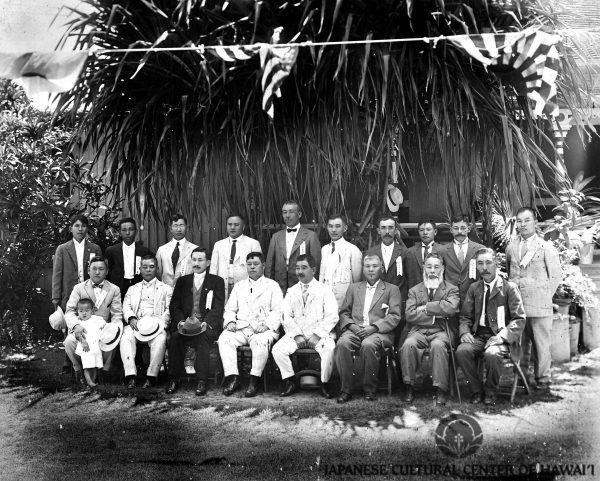Group Media & Photos

Undated. Front Row (L-R): Yokichi Tasaka (1st). Back Row: Ishichi Matsuda (1st), Miyakichi Ota (7th), Kazuyuki Kawano (9th), Katsuichi Kawamoto (10th). JCCH/Takuzo Kawamoto Collection.

Santa Fe Internment Camp, July 1943. Bottom Row (L-R): Ninryo Nago (5th), Rev. Kodo Fujitani (8th). 2nd Row: Matsujiro Otani (1st), Tsuruichi Sarae (3rd), Katsuichi Kawamoto (6th), Ryuten Kashiwa (10th). 3rd Row: Ryuichi Ipponsugi (1st), Yasutaro Soga (3rd). 4th Row: Kazuyuki Kawano (3rd), Rev. Tenran Mori (5th). Top Row: Hirouemon Yamamoto (2nd). JCCH/ Takuzo Kawamoto Collection.

Internees from Oahu. Santa Fe Internment Camp, 1944. Front row (L-R): Rev. Kogan Yoshizumi (3rd), Ryoichi Tanaka (5th), Nekketsu Takei (8th). Row 2: Mamoru Suga (2nd), Kazuyuki Kawano (3rd), Mannosuke Komu (5th), Masaichi Kobayashi (6th). JCCH/Joan Oya Collection.

Santa Fe Internment Camp. Row 1 (L-R): Shinjiro Matayoshi (2nd), Rev. Zenkai Tatsuguchi (5th), Rev. Zenko Saigusa (6th). Row 2 (L-R): Kazuyuki Kawano (2nd), Takeo Seike (3rd), Rev. Kakichi Okamoto (4th), Mankichi Miura (5th), Matsujiro Otani (7th), Rev. Kenjyo Ohara (8th), Rev. Daishin Ikejiri (9th). Row 3 (L-R): Rev. Doro Kanda (2nd, with tie), Hirouemon Yamamoto (4th), Tsuruichi Sarae (6th), Rev. Tenran Mori (7th), Sukenoshin Nakano (1st fr R). Row 4 (L-R): Riuichi Ipponsugi (2nd). JCCH/Riuichi Ipponsugi Archival Collection.

Men from Kumamoto Prefecture. Santa Fe Internment Camp. Front row (L-R): Kazuyuki Kawano (2nd), Toramatsu Matsumoto (3rd). Back row: Kiyoshi James Yonemura (3rd), Genpachi Tsushima (4th), Shigeru Yano (5th). JCCH/Matsumoto-Tsushima Family Collection.
Arrested: May 1942
Sand Island Internment Camp, Honolulu, Oahu Island
A group of 39 men (mostly Issei) were sent on the fourth transfer ship for internment in U.S. Army and Department of Justice camps on the Mainland. The internees were sent together from camp to camp. Some were paroled to War Relocation Authority camps and reunited with family members, others were transferred for repatriation to Japan.
Also sent on the same ship were six Issei women internees: Kiku Horibe, Miyuki Kawasaki, Yoshie Miyao, Yuki Miyao, Haru Tanaka, and Tsuta Yamane. The women were kept apart from the men and had a different internment sequence from them.
Angel Island Detention Facility, California
June 1942 - July 1942
Lordsburg Internment Camp, New Mexico
July 1942 - June 1943
Santa Fe Internment Camp, New Mexico
June 1943 - November 1944
Paroled to Grand Junction, Colorado
Returned to Hawaii: December 1945
Arrived in Honolulu with about 775 other internees aboard the military troopship the Shawnee.
Kazuyuki Kawano arrived in Hawaii from Kumamoto Prefecture in 1906 and a decade later opened a small retail store in Waipahu, Oahu. By the beginning of World War II, his shop had grown into a department store in an eponymous two-story building on Waipahu's main street, and Kawano was on the board of directors of the Honolulu Japanese Chamber of Commerce.
While Kawano was sent into internment on the Mainland, two of his sons served with the U.S. armed forces. Henry Toshio Kawano trained as a linguist at the Military Intelligence Service Language School at Fort Snelling, Minnesota. Roy Tomoaki Kawano was a member of the 100th Infantry Battalion.
In the postwar years, Kazuyuki Kawano joined with other prominent businessmen and returning Nisei soldiers to create Central Pacific Bank, a financial institution catering to the islands' large Japanese American population. He served on the bank's charter board of directors along with fellow internees Koichi Iida (also the bank's first CEO), Lawrence T. Kagawa, Sadato Morifuji, and Kinzo Sayegusa.
